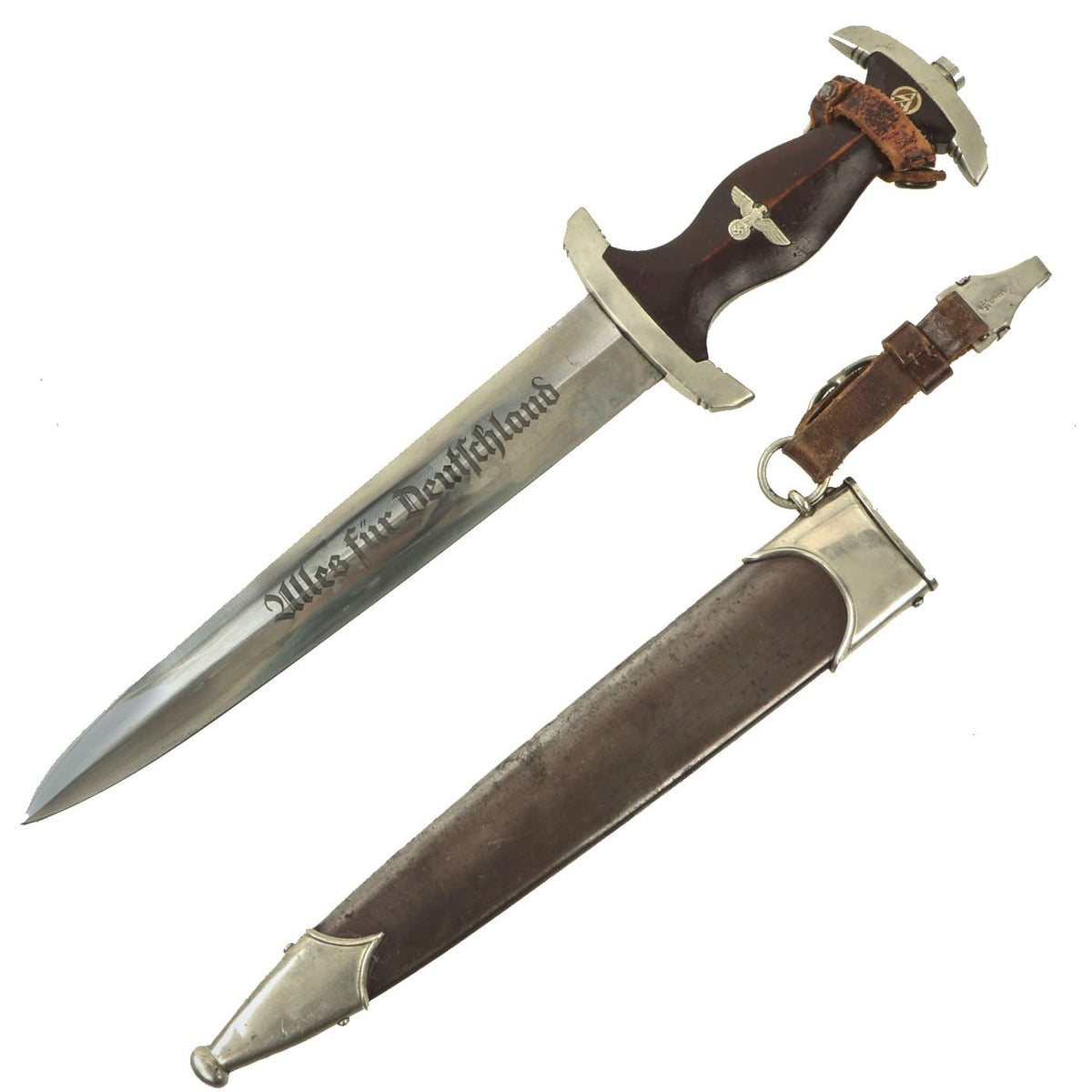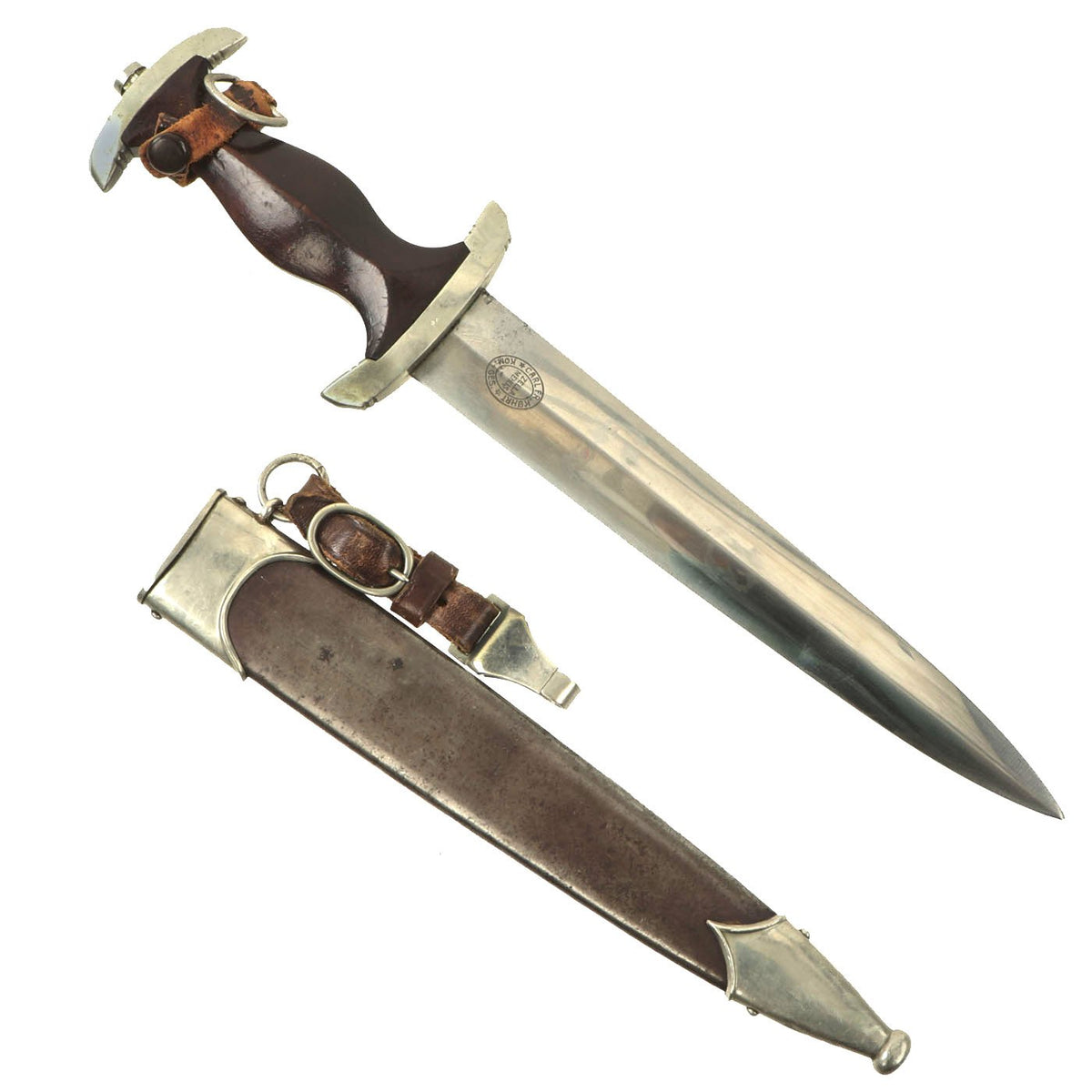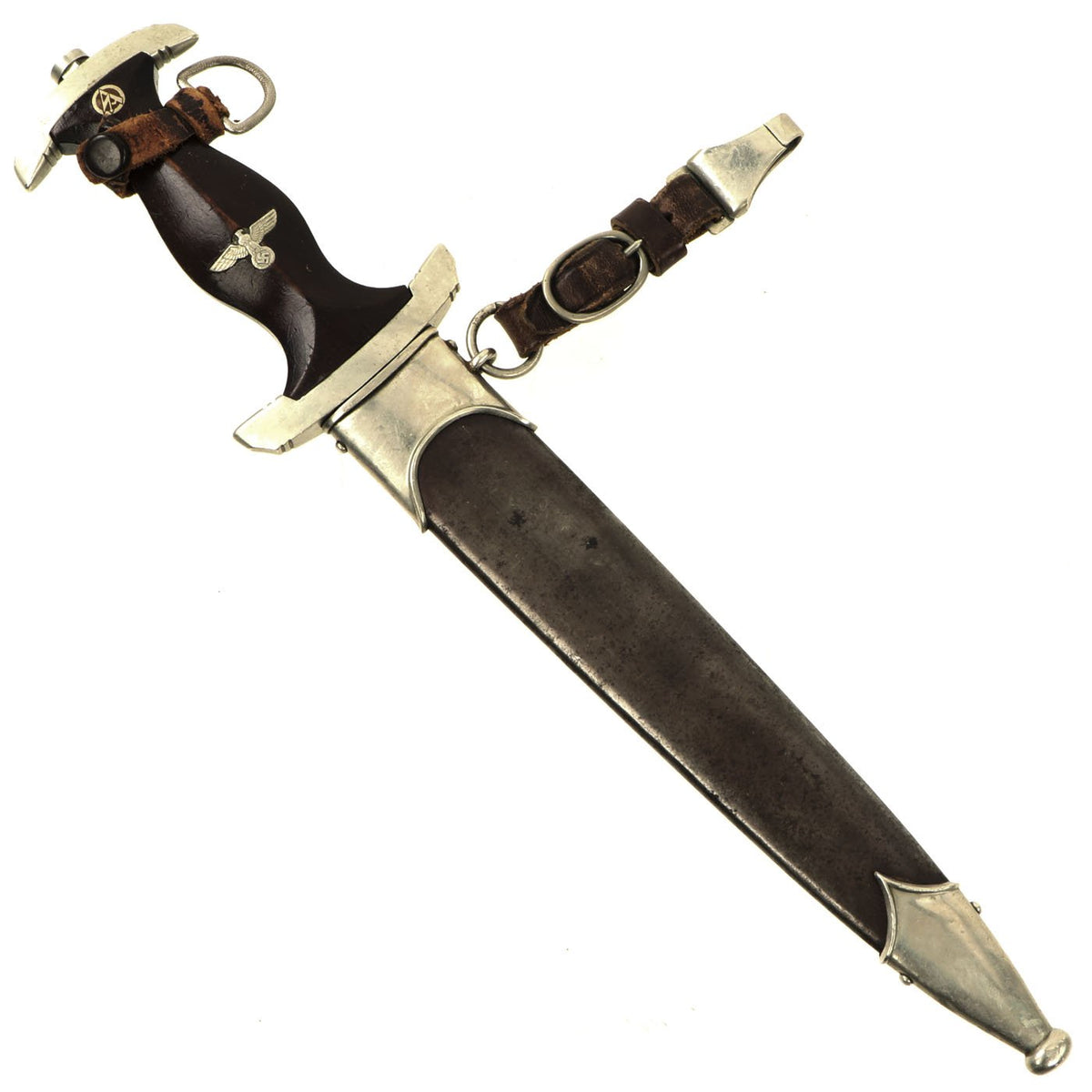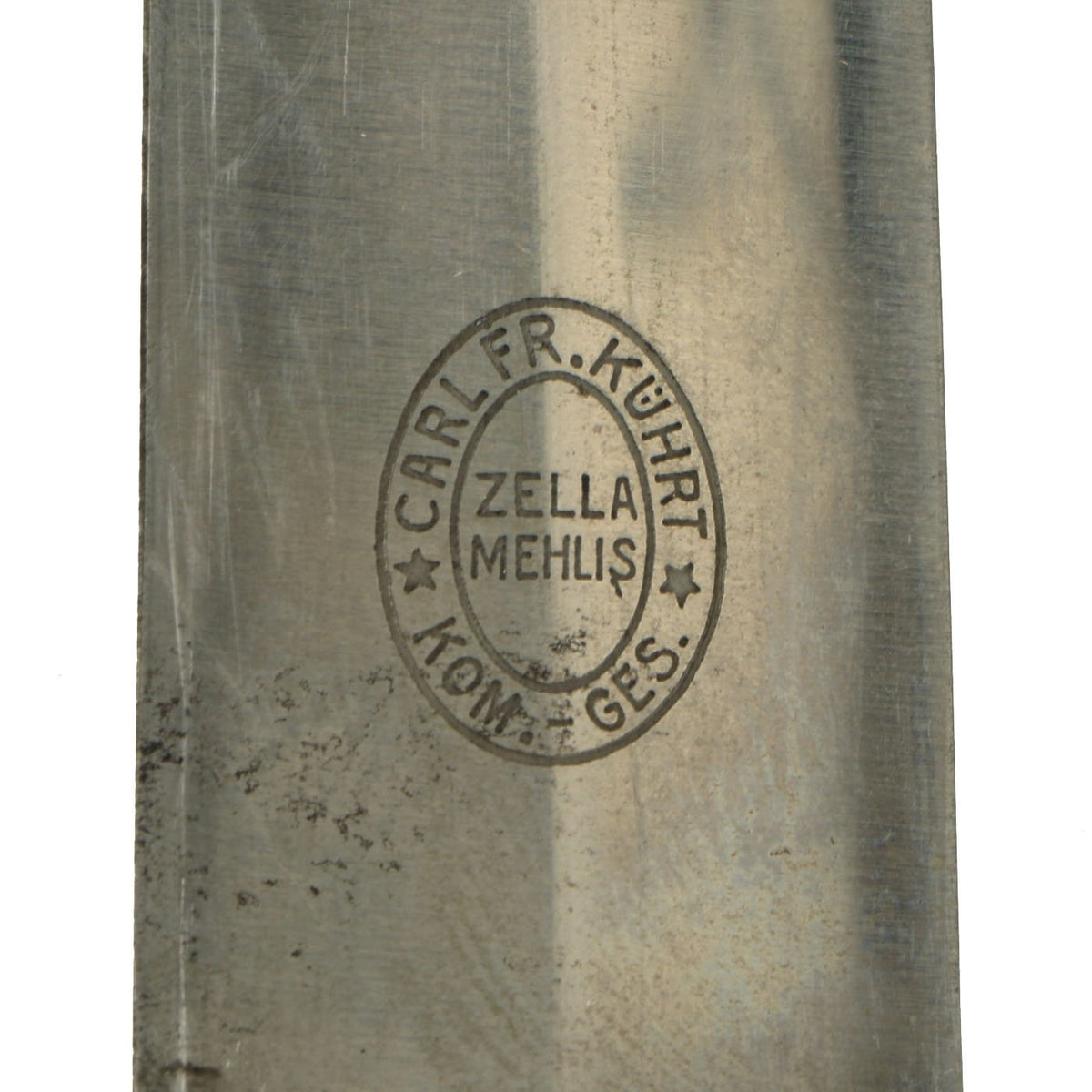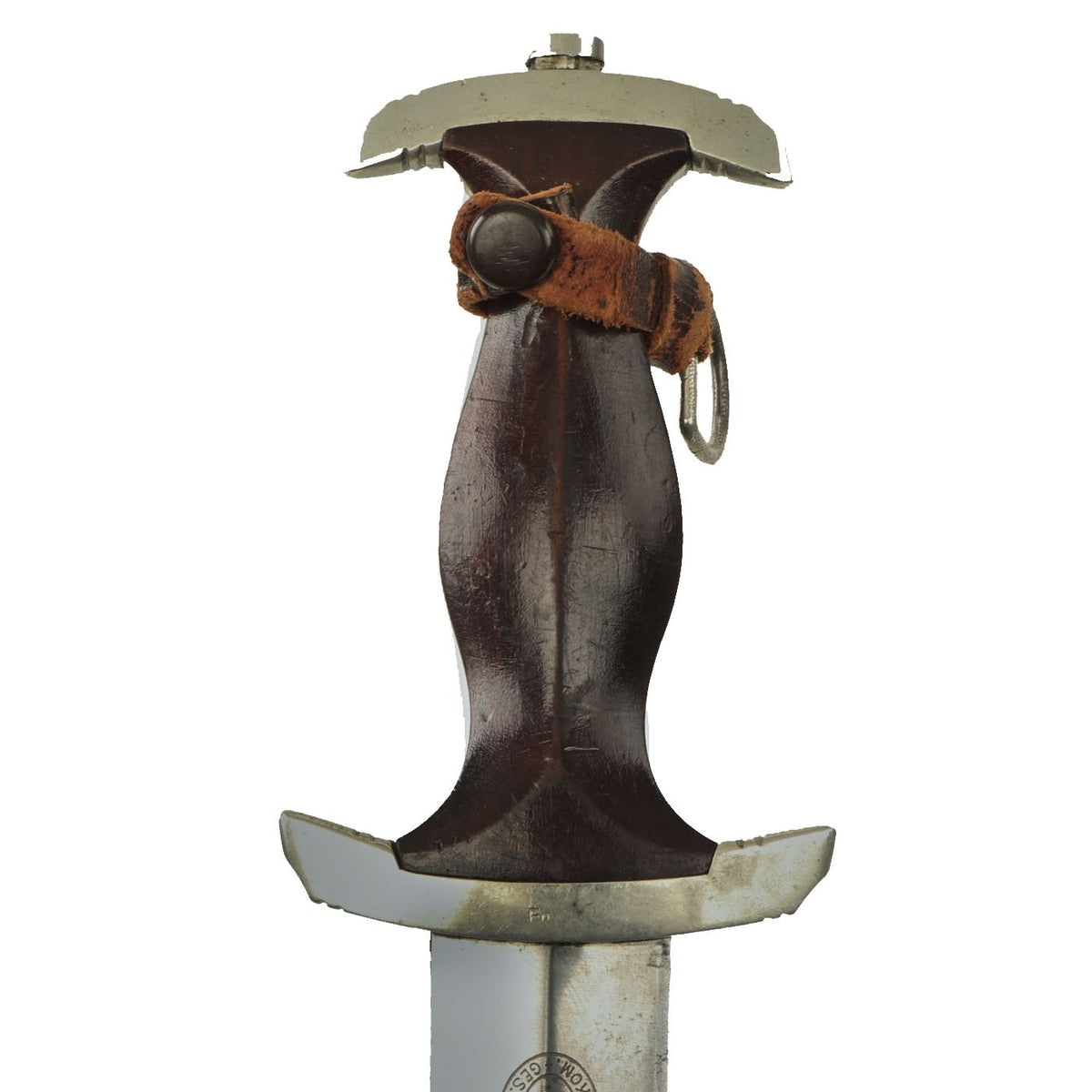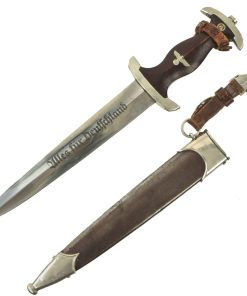Original German Early WWII SA Dagger by Rare Maker Carl. Fr. Kührt with Scabbard & 2 Point Hanger Original Items
$ 1.095,00 $ 273,75
Original Item: Only One Available. This is an very good condition early pattern SA Dagger, made by the very seldom seen firm of Carl. Fr. Kührt KG, based in Zella-Mehlis, Thuringia, Germany. This maker is EXTREMELY rare to find, and this is the first edged weapon of any type we have had by this firm. It comes comes compete with an original scabbard, which is in good shape.
The dagger has solid nickel silver fittings throughout, and is a nice example. The crossguards and tang nut are in very good condition throughout with all fittings having a nice lightly aged patina. There is a little age to these mounts but there is no lifting anywhere, showing that they are solid and not plated. They show very little wear or denting, if any, and the tang nut shows no evidence of being turned. The lower reverse guard is Gruppe/Gau marked Fr, for Franken, a district in west central Germany, with the principal cities being Nürnberg (Nuremberg) and Suhl.
The grip is a fine product having a nice dark reddish brown color, with medium center ridge construction, with just a bit of wear and a few small dents. This grip is in good condition and fits the crossguards nicely, with no cracks we can see, though there is just a bit of movement due to the wood shrinking. The symbol button is still nicely set, and still has most of the translucent enamel intact, with the nickel plating intact. The grip eagle is a fine example being the style with beak that points straight. It has just a bit of verdigris on it, showing that it is nickel alloy, though it is still quite shiny with little oxidaiton. The details are still there to the eagle to include the beak, breast feathering, wing feathering, talons, wreath and mobile swas.
The scabbard shell is mostly straight throughout and is the early-war style, with a brown “anodized” finish on the steel, which was then lacquered. There are a few dents, but they do not impede sheathing the dagger at all. All of the original lacquer has worn or flaked off, however the brown anodized finish is definitely still visible in places. The rest is faded to a lovely worn patina. The upper and lower fittings are solid nickel silver, with a great look and some dents and scratches showing typical wear. The chape is dented at the end, though not split, as the nickel alloy is somewhat soft, a common thing to see. The throat nicely matches the crossguards, and all fittings have their original dome headed screws, which do not show any signs of turning.
This fine example was produced by rare maker Carl. Fr. Kührt KG, and rear of the dagger is marked with the companies double oval address marking:
CARL FR. KÜHRT
ZELLA
MEHLIS
* KOM. – GES. *
The “KOM.-GES.” marking is short for Kommandit-Gesellschaft (Limited Partnership), a business entity used in Europe. This company was founded circa the turn of the century in Mehlis, Thuringia, and functioned as an Ironware maker, as well as a producer of screws and bolts. The 1939 DRAB identifies the owners as Louis, Otto, and Herbert Kührt. This company producted “A few early- period high quality SA daggers with German-silver fittings and fruitwood grips were made or completed by Kührt, marked with a double oval containing the town name in the center” per J. Anthony Carter’s GERMAN KNIFE AND SWORD MAKERS. Knives by this maker are extremely rare.
The blade is in excellent condition, with almost full factory cross grain! There is just a bit of light staining and peppering, as well as the usual wear from the scabbard runners. The acid-etched Alles für Deutschland (Everything for Germany) SA motto is crisp, with all of original darkening still present. The edge has not been sharpened, as is correct.
The leather belt hanger is the correct brown finished color, and is in very nice condition, considering the age. The hanger is a very interesting “2 point” setup, with a hanger strap on the ring as well as a second around the grip. This would hook to another two components attached to the belt, which are unfortunately missing. The nickel spring clip itself is marked with a “barred A” followed by D.R.G.M. (Deutsches Reiches Gebrauchs Musterschutz) – meaning it is a protected patented design under the Reich Government. This design was registered to the owner of the “Barred A” trademark, F. W. Assmann & Söhne of Lüdenscheid, a large maker of belts, buttons, and other accoutrements. There is some fading of the plating, but it has a great look.
An excellent early war SA dagger from a very rare maker, with a great original scabbard and rare hanger type. Ready to display!
Specifications:
Blade Length: 8 3/4″
Overall length: 13 3/4”
Crossguard: 3”
Scabbard Length: 10”
History of the SA-
The SA or Brown Shirts, were a private political formation which Adolf AH and the NSDAP used to maintain order at organized Party meetings and demonstrations. The group was formed in 1921, and grew to a huge force of nearly 3,000,000 men by the later 1930’s. To instill esprit de corps, as well as create employment for the Blade City of Solingen, it was decided each SA man would carry a dagger with his Brown Shirt uniform. Huge quantities needed to be produced to accommodate the demand. The dagger initially was produced of hand-fitted nickel mounts with attractive finished wood grip and brown anodized (a bluing process) finished scabbard.
The blade was etched with the SA motto, Alles für Deutschland. Examples produced prior to 1935 were stamped with the German sector of the SA group on reverse lower crossguard. Later examples underwent standardization through the RZM ministry. These pieces were produced of cheaper plated zinc-base fittings and scabbards were simply painted brown.
Prior to his “unmasking” as a traitor, Ernst Röhm was the leader of the SA. In 1934, he distributed approximately 100,000 SA daggers with his personal inscription on the reverse blade. These daggers were to honor individuals who had served with the SA prior to December, 1931. Other than the inscription, these pieces were identical to the standard M1933 SA dagger. After the Röhm purge, the inscription was ordered to be removed. Many examples were returned to the factory for grinding. Others were simply ground in the field by whatever means were available. Examples will occasionally be encountered with remnants of the original inscription remaining on the blade, but mostly none will remain. Some blades exist with an intact inscription, reflecting only the removal of the Röhm signature. Very very rarely is an example seen with a full, untouched inscription, as the holder would have surely risked a charge of treason.
Fast Shipping with Professional Packaging
Thanks to our longstanding association with UPS FedEx DHL, and other major international carriers, we are able to provide a range of shipping options. Our warehouse staff is expertly trained and will wrap your products according to our exact and precise specifications. Prior to shipping, your goods will be thoroughly examined and securely secured. We ship to thousands clients each day across multiple countries. This shows how we're dedicated to be the largest retailer on the internet. Warehouses and distribution centres can be located throughout Europe as well as the USA.
Note: Orders with more than one item will be assigned a processing date depending on the item.
Before shipping before shipping, we'll conduct a thorough inspection of the items you have ordered. Today, the majority of orders will be delivered within 48 hours. The delivery time will be between 3-7 days.
Returns
The stock is dynamic and we cannot completely manage it because multiple stakeholders are involved, including our factory and warehouse. So the actual stock may alter at any time. It's possible that you may not receive your order once the order has been made.
Our policy is valid for a period of 30 days. If you don't receive the product within 30 days, we are not able to issue a refund or an exchange.
You can only return an item if it is unused and in the same state as the day you received it. You must have the item in its original packaging.
Related products
Uncategorized
Uncategorized
Uncategorized
Uncategorized
Uncategorized
Uncategorized
Uncategorized
Uncategorized
Uncategorized
Uncategorized
Uncategorized
Uncategorized
Uncategorized
Uncategorized
Australian WWII Owen MK1 Machine Carbine SMG Custom Fabricated Replica with Sling Original Items
Uncategorized
Uncategorized
Armoured Fighting Vehicles of the World: AFVs of World War One (Hardcover Book) New Made Items
Uncategorized
Uncategorized
